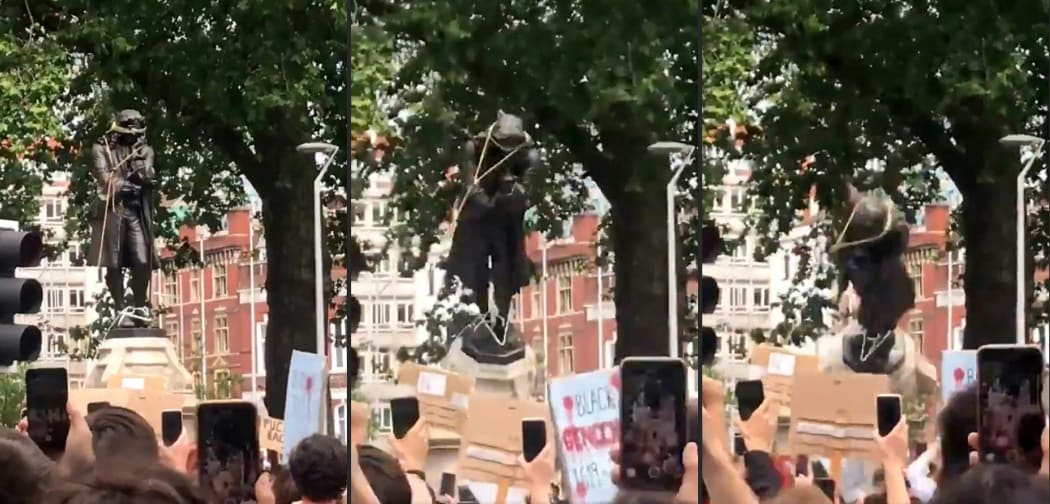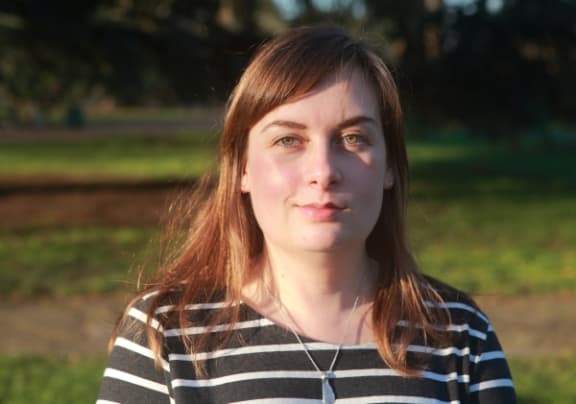The call to remove statues and place names that honour racist figures from history is gaining momentum.

A series of images showing protesters pulling down a statue of slave trader Edward Colston in Bristol. Photo: AFP / Twitter / William Want/@willwantwrites
In Bristol last weekend, a statue of slave merchant Edward Colston was thrown into the harbour by Black Lives Matters protesters.
And here in New Zealand a statue of Captain John Hamilton was removed from Civic Square in Hamilton after pressure from local iwi.

Charlotte Lydia Riley Photo: supplied
Kaumatua Taitimu Maipi, who had threatened to remove the statue himself, described the battle of Gate Pā leader as a "murderous arsehole".
Are these actions erasing history, or simply correcting it?
Charlotte Lydia Riley - a historian of contemporary Britain at the University of Southampton - is writing a revisionist history of post-war imperial Britain called Imperial Island.
She believed the removal of the Edward Colston statue was a good thing and said it had been controversial for a long time.
There had been efforts made to put a plaque on the statue to give it some context, but there had been ongoing arguments about what it could possibly say.
She said it was important to remember that even with a plaque explaining things further, the current argument around such statues was about due prominence.
"Statue aren't neutral objects, they're not just there to tell history, statues are there to commemorate. They're there to celebrate. We don't put up statues of people we don't want to remember positively," she said.
While the death of George Floyd in the US had started the protests that toppled the statue, Riley said there was a British context to remember also.
"Particularly in Britain, there has been a lot of concern that black and minority ethnic people are disproportionally likely to die from covid-19, that they're more likely to be in the kind of front line jobs where they're exposed to this, they're more likely to be low paid workers.
"It has happened in a particular context where we were already having very critical searching conversations about racism in British society."
Riley said conversations around the Colston statue had been difficult, as many Britons took pride in Britain's role in ending the slave trade, which she said was partly a product of the education system in the country and a "pick and mix" attitude to history.
"The people who are centred in these discussions are people like William Wilberforce, so it's often white British figures who are centred in these ideas about abolition.
"So British people will tell you very proudly that Britain ended the slave trade, or the Royal Navy was instrumental in ending the slave trade, or in policing the sea to stop other countries trading in slaves.
"People select aspects that they're very happy about and want to be proud of, but they don't want to feel guilty for the kinds of historical sins."
When it came to judging the past by the standards of the present, Riley said this was actually the only way to look at history - by using the frameworks of our experiences and identities to bring our own perspectives on the past.
"I think there's two things to say about that and the first thing is that it's not just through our standards that these people are problematic. During the slave trade, people were campaigning against slavery. It's not like everybody was a slave trader when this was happening, everyone thought this was a wonderful idea and a very moral activity.
"The second thing is, when we talk about viewing the past through the eyes of the present, statues are part of the present. They might be depicting figures of the past that are being commemorated because of things that they did long ago, but their existence is in the here and now, they are in our contemporary towns and cities."
As a result of the removal of the Edward Colston statue, a museum in Bristol had also made another important historical discovery when they pulled the statue out of the harbour - a magazine from 1885 was found shoved inside the statue, with the names of the workers who erected it inscribed inside the cover.
"They never would have found it if the statue hadn't come down," she said. "It was also a moment of remembering - people were here and workers did this."
However, the removal of statues was always going to be a painful process for some, she said.
"People clearly feel very strongly about it and people build their identities and nations built their identities on history ... so when you start to pull at the threads, you start to try and unravel stories that people have quite emotional connections to, that's always going to be really complicated and it's always going to be something that some people find very painful."

